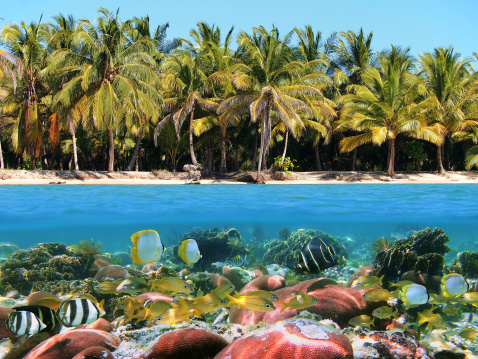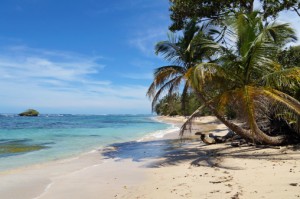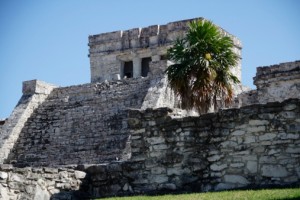Cozumel

Cozumel, Mexico, should not be compared to Cancun, the splashy resort just 40 mi/65 km to the north and one of its nearest neighbors. In the past, Cozumel had a laid-back, sedate atmosphere, and its superior fishing, snorkeling and diving gave it a definite edge.
Today, Cozumel retains its unique vibe and remains a better choice for those who don’t like planned resorts, but the island is no longer an escapist’s paradise. The snorkeling, diving and fishing are still great, but no one would mistake present-day Cozumel for the sleepy backwater it once was.
One reason is cruise ships. Cozumel is the most popular cruise stop in Mexico and can host as many as four large ships simultaneously. When more than one ship looms on the horizon, Cozumel’s restaurants, bars and shops fill with day-trippers. Everyone, from shopkeepers to bartenders, gets a bit stressed by the crowds.
Still, Cozumel can be fun, especially for travelers interested in exploring its coral reefs on scuba and snorkeling outings. The island’s only town, San Miguel, has retained much of its pleasant, small-town atmosphere. Those with enough time for a day trip will find the Mayan ruins of Tulum and Chichen Itza, on the Yucatan mainland, within striking distance.
| Country | Mexico |
|---|---|
| Languages spoken | Spanish is the main language, but English is widely spoken. A few people speak Maya. |
| Visa requirements | Passport/Visa Requirements: Australian and U.K. citizens need passports. The Mexican government charges a tourism tax of about US$22 for all visitors except cruise-ship passengers and a departure tax of US$40, though both are usually included in the price of your airline ticket. A yellow-fever certificate is required if you're arriving from an infected area (contact health authorities for the latest information). All U.S. citizens must have a passport when traveling by air to or from Bermuda, Canada, the Caribbean, Central and South America, and Mexico. Citizens of Canada, Mexico and the British Overseas Territory of Bermuda also must have a passport or other designated secure document to enter the U.S. Passports are required for land crossings at the Canadian and Mexican borders with the U.S. and for cruise passengers returning to the U.S. from Mexico, the Caribbean, Canada or Bermuda. Reconfirm travel-document requirements with your carrier prior to departure. |

 Nearly all recreation on the island centers around the picturesque beachfront, with snorkeling, scuba diving, sportfishing, windsurfing and sailing the most popular activities. Golf, tennis and horseback riding are also common. There are three types of beaches on Cozumel. First, there are some stretches of white sand on the west side of the island, where most of the resorts and attractions are located. These beaches front mostly calm, turquoise-colored water sheltered by the Yucatan mainland, making it good for swimming and snorkeling. The best of the sandy beaches are Playa Azul, Playa Pila and Playa San Juan to the north; and Playa San Francisco, Playa Mia Grand Beach Park, Mr. Sancho's, Nachi Cocom and Playa Palancar to the south.
Also on the west side of the island, you'll find "beaches" made of brown limestone, a phenomenon known as "iron shore." To get into the water, you'll usually have to use a set of steps or a ladder from the shore or from a pier. Although iron shore isn't as picturesque as the white beaches, such areas are usually better for snorkeling. The waterfront at Parque Nacional Chankanaab is iron shore, but some sand has been trucked in to create a more pleasant sunning area.
On the east side of the island, facing the open waters of the Caribbean Sea, there are pristine beaches of white sand that are largely deserted. They're beautiful, but the water there can be dangerous, plagued by rough surf and dangerous undertows (which is why so few people frequent the beaches). These shores can be good for lounging, but we recommend that you stay out of the water. You should also keep in mind that the east side is mostly uninhabited save for a few ramshackle but charming restaurants and beach bars.
Groups can also sign up for Jeep tours and kayaking excursions.
Nearly all recreation on the island centers around the picturesque beachfront, with snorkeling, scuba diving, sportfishing, windsurfing and sailing the most popular activities. Golf, tennis and horseback riding are also common. There are three types of beaches on Cozumel. First, there are some stretches of white sand on the west side of the island, where most of the resorts and attractions are located. These beaches front mostly calm, turquoise-colored water sheltered by the Yucatan mainland, making it good for swimming and snorkeling. The best of the sandy beaches are Playa Azul, Playa Pila and Playa San Juan to the north; and Playa San Francisco, Playa Mia Grand Beach Park, Mr. Sancho's, Nachi Cocom and Playa Palancar to the south.
Also on the west side of the island, you'll find "beaches" made of brown limestone, a phenomenon known as "iron shore." To get into the water, you'll usually have to use a set of steps or a ladder from the shore or from a pier. Although iron shore isn't as picturesque as the white beaches, such areas are usually better for snorkeling. The waterfront at Parque Nacional Chankanaab is iron shore, but some sand has been trucked in to create a more pleasant sunning area.
On the east side of the island, facing the open waters of the Caribbean Sea, there are pristine beaches of white sand that are largely deserted. They're beautiful, but the water there can be dangerous, plagued by rough surf and dangerous undertows (which is why so few people frequent the beaches). These shores can be good for lounging, but we recommend that you stay out of the water. You should also keep in mind that the east side is mostly uninhabited save for a few ramshackle but charming restaurants and beach bars.
Groups can also sign up for Jeep tours and kayaking excursions.  The oldest Maya ruin on Cozumel dates from AD 300. The Maya believed that Cozumel was the spiritual home of Ixchel, the goddess of fertility and love. Maya women and men were said to make a pilgrimage to the island at least once in their lifetimes to ensure the healthy birth of their children.
The name Cozumel comes from the Mayan word Cuzamil-Peten, which means "Land of the Swallows." (Ixchel was often depicted with swallows at her feet.)
Cozumel was a quiet place until the early 1960s, when it was first visited by Jacques Cousteau, the well-known underwater explorer and documentary filmmaker. He put the island on the map as one of the great diving destinations in the world.
In recent decades, Cozumel has experienced the tourism boom that has transformed the northern Yucatan, and it has become an increasingly popular destination for cruise ships.
The oldest Maya ruin on Cozumel dates from AD 300. The Maya believed that Cozumel was the spiritual home of Ixchel, the goddess of fertility and love. Maya women and men were said to make a pilgrimage to the island at least once in their lifetimes to ensure the healthy birth of their children.
The name Cozumel comes from the Mayan word Cuzamil-Peten, which means "Land of the Swallows." (Ixchel was often depicted with swallows at her feet.)
Cozumel was a quiet place until the early 1960s, when it was first visited by Jacques Cousteau, the well-known underwater explorer and documentary filmmaker. He put the island on the map as one of the great diving destinations in the world.
In recent decades, Cozumel has experienced the tourism boom that has transformed the northern Yucatan, and it has become an increasingly popular destination for cruise ships.